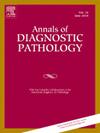Diagnostic challenges and considerations in CD30-negative classical Hodgkin lymphoma from biopsy specimens
IF 1.4
4区 医学
Q3 PATHOLOGY
引用次数: 0
Abstract
This study aimed to investigate the clinicopathological features and diagnostic strategies of CD30-negative classic Hodgkin lymphoma (cHL) based on core needle biopsy specimens. Six cases diagnosed at Yantai Yuhuangding Hospital and Beijing Gaobo Boren Hospital were retrospectively analyzed. The diagnosis was established through integrated evaluation of histomorphology and immunohistochemical (IHC) profiling. All cases underwent repeated CD30 immunostaining using multiple antibody clones and platforms to confirm true CD30 negativity. The cohort comprised five males and one female (male-to-female ratio 5:1), with a median age of 17.5 years (range: 6–86 years). Histological subtypes included four cases of mixed cellularity and two of nodular sclerosis, all demonstrating characteristic morphological features of cHL. CD30 expression was entirely absent in five cases and weakly positive in scattered tumor cells in one case. To ensure diagnostic accuracy, repeat biopsies were performed in four patients. IHC analysis revealed consistent expression of PAX5, C-MYC, ATF3, and p53 in all six cases, with variable positivity for CD20 (3/6), LCA (1/6), MUM1 (4/6), OCT2 (4/6), and BOB.1 (1/6). Epstein-Barr virus–encoded RNA (EBER) was positive in five cases (83.3 %), with none of the cases undergoing flow cytometry (FCM). Five patients received ABVD chemotherapy; four achieved complete remission, one died, and one was lost to follow-up. IDiagnosis was established based on histomorphological identification of Reed–Sternberg–like cells within a characteristic inflammatory background, in conjunction with an extended immunophenotypic panel. CD30 immunostaining was repeated using different clones and platforms to exclude technical artifacts. In cases with persistent CD30 negativity, complete excision was performed when feasible, and diagnosis was confirmed only if R-S–like cells concurrently exhibited: (1) variable or weak CD20 and LCA expression, never both strongly positive; (2) weak or absent PAX5 and MUM1; (3) discordant BOB.1 and OCT2 expression; and (4) positive c-MYC, p53, and ATF3 nuclear staining. Cases failing to meet all criteria were excluded. In conclusion, CD30-negative cHL diagnosed on limited biopsy material tends to affect younger male patients and retains typical morphological and immunophenotypic hallmarks of cHL. A thorough diagnostic approach incorporating multi-clone CD30 IHC and repeat sampling when necessary is crucial to avoid misdiagnosis in these diagnostically ambiguous cases.
cd30阴性经典霍奇金淋巴瘤活检标本的诊断挑战和考虑
本研究旨在探讨cd30阴性经典霍奇金淋巴瘤(cHL)的临床病理特征和诊断策略。回顾性分析在烟台玉皇顶医院和北京高博博人医院诊断的6例病例。诊断是通过组织形态学和免疫组化(IHC)分析的综合评估建立的。所有病例均使用多个抗体克隆和平台进行重复CD30免疫染色以确认CD30阴性。该队列包括5男1女(男女比例为5:1),年龄中位数为17.5岁(范围:6-86岁)。组织学亚型包括4例混合细胞性和2例结节性硬化,均表现出cHL的典型形态学特征。5例CD30表达完全缺失,1例分散肿瘤细胞表达弱阳性。为了确保诊断的准确性,4例患者进行了重复活检。免疫组化分析显示,所有6例患者中PAX5、C-MYC、ATF3和p53的表达一致,CD20(3/6)、LCA(1/6)、MUM1(4/6)、OCT2(4/6)和BOB.1(1/6)的表达不同。Epstein-Barr病毒编码RNA (EBER)阳性5例(83.3%),流式细胞术(FCM)检测均为阴性。5例患者接受ABVD化疗;4例完全缓解,1例死亡,1例随访失败。i诊断是基于特征性炎症背景下reed - sternberg样细胞的组织形态学鉴定,并结合扩展的免疫表型面板建立的。使用不同的克隆和平台重复CD30免疫染色以排除技术伪影。对于持续CD30阴性的病例,在可行的情况下进行完全切除,只有当r - s样细胞同时表现出:(1)CD20和LCA表达可变或弱,从未同时呈强阳性;(2) PAX5和MUM1弱或缺失;(3) BOB.1和OCT2表达不一致;(4) c-MYC、p53、ATF3核染色阳性。不符合所有标准的病例被排除在外。总之,在有限的活检材料上诊断出cd30阴性的cHL倾向于影响年轻男性患者,并保留了cHL的典型形态学和免疫表型特征。一个彻底的诊断方法,包括多克隆CD30 IHC和必要时重复采样是至关重要的,以避免误诊这些诊断模糊的病例。
本文章由计算机程序翻译,如有差异,请以英文原文为准。
求助全文
约1分钟内获得全文
求助全文
来源期刊
CiteScore
3.90
自引率
5.00%
发文量
149
审稿时长
26 days
期刊介绍:
A peer-reviewed journal devoted to the publication of articles dealing with traditional morphologic studies using standard diagnostic techniques and stressing clinicopathological correlations and scientific observation of relevance to the daily practice of pathology. Special features include pathologic-radiologic correlations and pathologic-cytologic correlations.

 求助内容:
求助内容: 应助结果提醒方式:
应助结果提醒方式:


